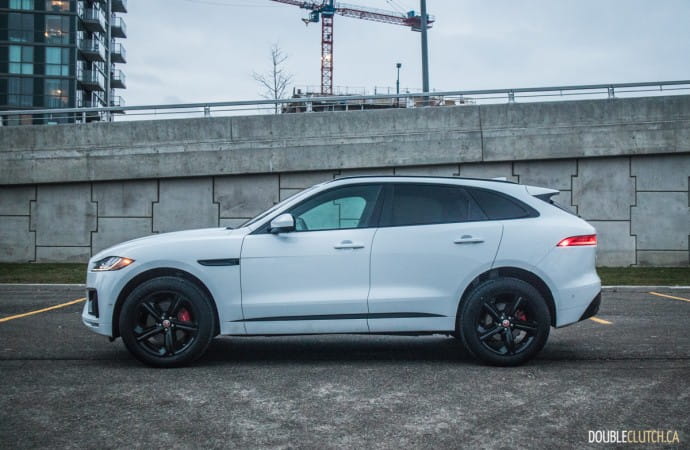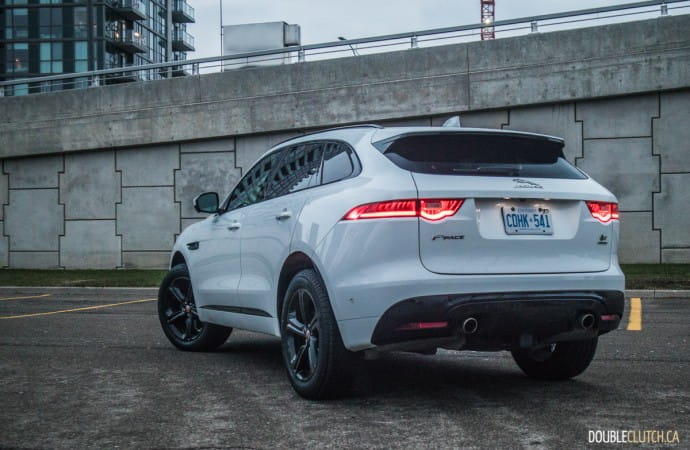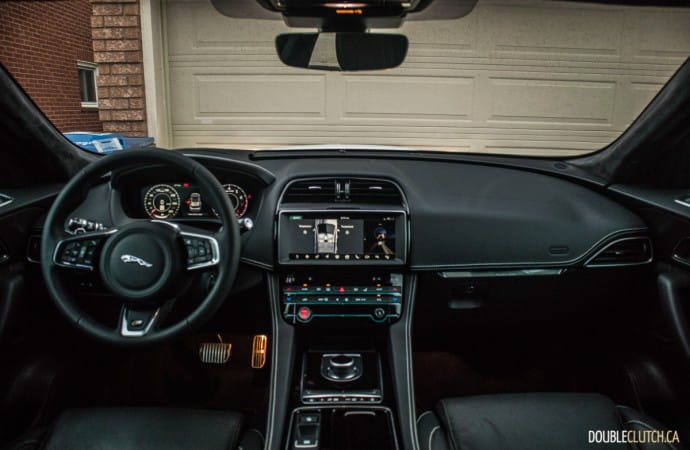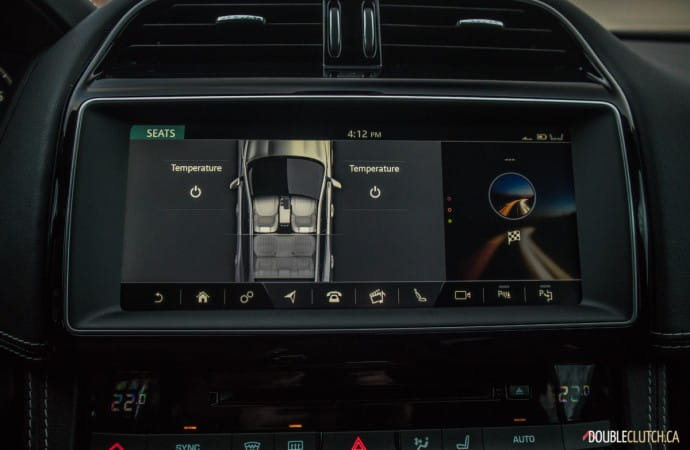With popular entrants from BMW, Mercedes-Benz, and Audi, it was only a matter of time before the British decided to jump in on the action. The stylish F-Pace was introduced for the 2017 model year, and is now offered with a variety of powertrain choices including a four-cylinder diesel. We jumped behind the wheel of the 2019 Jaguar F-Pace S, the top trim model in the lineup, to see what it has to offer.
The F-Pace is arguably the best-looking premium crossover in its class. The BMW X3 (reviewed here) and Audi Q5 are quite conservative in appearance, with the Mercedes-AMG GLC 43 being the other looker of the bunch. The F-Pace’s lines are distinctively Jaguar, with wide hips and a crisp and fresh looking take on the traditional crossover. The angular design does affect cargo capacity (650L behind the rear seats), but the seats fold flat and this somewhat makes up for the angle of the rear hatch. LED lighting front and rear brings everything together nicely, and a “Jaguar” logo is projected onto the ground beside the front doors at night, simulating a welcome mat.
One area in which the F-Pace S absolutely demolishes its competition is in the way that it drives. The supercharged 3.0L V6 is one we have sampled throughout the Jaguar lineup, and in this application offers 380 horsepower at 6,500RPM and 332 lb-ft. of torque at 4,500RPM. It makes a glorious noise on acceleration, though if left in “Dynamic” mode this setup does drone a bit on the highway. An eight-speed automatic sourced from ZF sends power to the wheels through a slip-and-grip all-wheel-drive system.
This Jaguar is the only premium crossover in the compact segment to offer a supercharger instead of a turbocharged setup. The Volvo XC60 (reviewed here) can be had with a twin-charged motor, but that is more of a comfort-oriented setup rather than straight performance like this F-Pace S. Power delivery is absolutely immediate and this crossover builds speed very quickly – Jaguar Canada claims a 0-100km/h sprint in just 5.5 seconds.
Jaguar’s all-wheel-drive system sends 100% of power to the rear wheels by default. When it detects slip, it can send up to 50% to the front wheels as well, making for a true enthusiast setup (as far as crossovers are concerned, anyway). It’s genuinely fun to push around some of our favourite twisty roads, though the higher center of gravity has us favouring the XE S (reviewed here) sedan. One worthy competitor that’s a little bit more expensive when comparably equipped is Porsche’s Macan GTS.
Ride quality is on the firmer side, but the Adaptive Dynamics system adjusts everything from powertrain setup to the adjustable dampers to set the F-Pace up to your liking. In “Dynamic”, everything is quite firm and sporty, very reminiscent of the F-Type (reviewed here) sports car that the F-Pace very obviously shares its personality with. The electric power steering is fairly responsive, and well weighted. It’s not every day that a Jaguar crossover has better steering and handling than the comparable BMW application, but with this F-Pace S, we’ve reached that point.
Long story short – it drives very, very well. The Jaguar is the best driving thing among its competitors, and is likely one of the best looking as well. There has to be a penalty somewhere, and it comes in the form of fuel economy. The curb weight is pushing 4,200lb., and this means that even in just highway driving, the F-Pace S can’t do much better than 9.9L/100km. Over the course of our test, we averaged 12.4L/100km running on 91-octane premium fuel. The tank will hold 82L of it, and realistically will allow for approximately 600km on a single tank.
Interior appointments on the F-Pace are fairly reasonable, but even in S trim, they feel a bit bland. The two-tiered door panel has the power window controls right on the window sill, which is a Jaguar-Land Rover thing but could take some getting used to. Materials are very nice, with leather and aluminum used throughout, and the seats are very comfortable. There’s plenty of space for front seat passengers (the seats are also heated and cooled), but rear accommodations are on the tighter side. With the panoramic sunroof, headroom is impacted, but the rear seats do recline and are heated.
The infotainment is controlled via Jaguar’s InControl Touch Pro system, which is much easier and cleaner to use than the Pro Duo system on some of the newer Land Rover applications. There are still hard buttons for major controls, which makes turning on things like the heated seats and steering wheel a cinch in colder weather. The system has a series of InControl apps that are built-in, however Jaguar remains the only luxury brand to not offer Apple CarPlay or Android Auto. This has been rectified in the upcoming Range Rover Evoque, so we’re excited to try out the new system.
The standard F-Pace with its 2.0L turbo-four starts at just $57,500, though stepping up to the S will cost buyers $69,900. It comes standard with the bigger engine, 20” wheels, 18-way power seats and more. Our test vehicle had black wheels, and a few other packages including a Black Pack, Comfort and Convenience Package (heated and cooled seats, reclining rear seats), Driver Assist Package (Blind Spot Assist, Adaptive Cruise Control), and a Technology Package that adds a Meridian stereo and 12.3” touchscreen. This brings the total price to just over $80,000.
It may not be cheap, but there is a distinct advantage to the 2019 Jaguar F-Pace S – it really is one of the better driving crossovers. It’s also the more interesting choice in most Canadian urban centers, where the German models seem to rule. If all-wheel-drive, ground clearance and the practicality of the rear cargo area is a high priority, this purring kitty may be worth a second glance.


















































